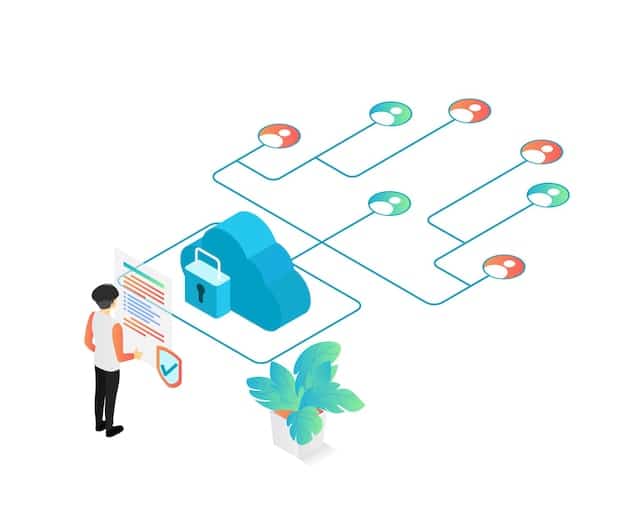VPNs for Business: Secure Remote Workforce in 2025

Ensuring robust cybersecurity for a distributed workforce in 2025 mandates a strategic approach to Virtual Private Networks for businesses, focusing on solutions that balance security, scalability, and ease of management to protect sensitive data and maintain operational continuity.
As the landscape of work evolves, with remote and hybrid models becoming the norm, the imperative to secure company data intensifies. Choosing the right VPNs for business: choosing the right solution to secure your remote workforce in 2025 is not just a technical decision; it’s a strategic investment in your organization’s resilience against an increasingly sophisticated threat environment.
The Evolving Need for Business VPNs in 2025
The traditional office perimeter has all but dissolved, replaced by a distributed ecosystem where employees access critical resources from diverse locations and devices. This shift has placed immense pressure on IT departments to maintain robust security postures without impeding productivity. In 2025, a business VPN is no longer a luxury but a fundamental component of enterprise cybersecurity, serving as the first line of defense for remote access.
This section explores why VPNs remain indispensable and how their role has adapted to meet new challenges. The increasing complexity of cyber threats, from sophisticated phishing attacks to ransomware, demands a layered security approach, with the VPN acting as a critical enabler of secure communication channels. Organizations must move beyond basic VPN implementations, adopting solutions that offer advanced features tailored to modern business needs.
Beyond Basic Tunneling: Advanced VPN Features for Enterprise
Modern business VPNs offer much more than simple encrypted tunnels. They incorporate features designed to enhance security, improve performance, and simplify management for large, dispersed teams. These advanced capabilities are paramount for safeguarding corporate assets in an era of ubiquitous remote work.
- Multi-Factor Authentication (MFA) Integration: Enhances login security by requiring multiple verification methods, significantly reducing unauthorized access risk.
- Granular Access Controls: Allows administrators to define precise access policies, ensuring employees only connect to resources relevant to their roles, adhering to the principle of least privilege.
- Split Tunneling: Optimizes network performance by routing only corporate traffic through the VPN, while personal internet traffic bypasses it, reducing bandwidth strain.
Furthermore, the integration of VPNs with existing identity management systems streamlines user authentication and provisioning, making it easier to scale security measures across the organization. The ability to audit VPN connections and user activities provides crucial insights for compliance and incident response.
In essence, the role of VPNs has expanded from merely securing connections to becoming an integral part of a broader security framework. Companies must evaluate VPN solutions based on their ability to integrate with other security tools and support evolving business processes. The solution chosen today should be capable of adapting to future technological advancements and emerging threat landscapes.
Key Considerations for Choosing a Business VPN Solution
Selecting the optimal VPN for business requires a thorough evaluation of several critical factors. It’s not just about speed or encryption; it’s about finding a solution that aligns with your operational needs, security requirements, and long-term strategic goals. A well-chosen VPN should support seamless remote work while providing ironclad protection for sensitive data.
The decision-making process should involve key stakeholders from IT, security, and even HR, to ensure all aspects of remote work are covered. Understanding the specific challenges and unique requirements of your workforce is paramount before committing to any solution.
Scalability and Performance: Meeting Demand in 2025
As your remote workforce grows, your VPN solution must be able to scale effortlessly without compromising performance. Latency and slow connection speeds can severely impact productivity and user experience. Businesses in 2025 need VPNs that can handle a significant number of concurrent connections and high data throughput.
Consider solutions that offer load balancing, global server networks, and efficient tunneling protocols to ensure high availability and minimal disruption. Performance benchmarks, especially for file transfers and video conferencing, should be a significant part of your assessment. The chosen VPN should not become a bottleneck for critical business operations.
Security Protocols and Encryption Standards
The foundation of any VPN is its security. In 2025, outdated encryption standards or weak protocols are simply unacceptable. Look for VPNs that utilize robust, industry-standard protocols like OpenVPN, IKEv2/IPsec, or WireGuard, paired with strong encryption algorithms like AES-256. These provide the necessary cryptographic strength to protect data in transit.
Additionally, examine the provider’s stance on logging. A strict no-logs policy is crucial for privacy and security, ensuring that no records of your employees’ online activities are retained. Understanding the underlying security architecture is vital for maintaining a strong defensive posture against cyber threats.

User Experience and Management Simplicity
A powerful VPN is only effective if your employees can use it easily and your IT team can manage it efficiently. Complex interfaces or cumbersome connection procedures can lead to user frustration and, critically, security bypasses. Look for intuitive client applications across various platforms (Windows, macOS, Linux, iOS, Android).
- Ease of Deployment: Can the VPN be quickly rolled out to all endpoints?
- Centralized Management Console: Does it offer a unified portal for user management, policy enforcement, and monitoring?
- Technical Support: Is responsive and knowledgeable support available 24/7?
The ease of management extends to features like automated updates, remote configuration, and detailed analytics. These capabilities enable IT administrators to proactively address issues and maintain a secure and efficient VPN environment with minimal manual intervention.
Ultimately, the best VPN for your business is one that offers a harmonious blend of high-end security, top-tier performance, and a user-friendly experience for both your workforce and your IT staff. Invest time in pilot programs and user feedback before making a final decision.
Different Types of Business VPN Solutions
The market offers a range of VPN solutions, each with its own strengths and ideal use cases. Understanding the distinctions between these types is crucial for choosing the one that best fits your organization’s size, budget, and specific security needs. From traditional remote access VPNs to more modern zero-trust network access models, the options are diverse.
This section will break down the common categories of business VPNs, highlighting their core functionalities and suitability for different enterprise scenarios in 2025. The shift towards cloud-based infrastructures and increasing sophistication of cyberattacks demands a careful consideration of each solution’s capabilities.
Remote Access VPNs: The Traditional Choice
Remote access VPNs are perhaps the most common type of business VPN. They allow individual users to securely connect to the corporate network from remote locations. This is achieved by creating an encrypted tunnel from the user’s device to a VPN server on the corporate network. Once connected, the remote user functions as if they were physically present in the office, accessing internal resources.
- Pros: Established technology, broad vendor support, relatively straightforward to implement for smaller organizations.
- Cons: Can be a single point of failure, often provides broad network access (not granular), scalability challenges for very large workforces, performance issues with high traffic.
While still widely used, the “trust at the perimeter” model of traditional remote access VPNs is increasingly being challenged by more agile and secure alternatives like Zero Trust Network Access (ZTNA), especially for larger, more complex environments.
Site-to-Site VPNs: Connecting Branch Offices
Site-to-site VPNs are designed to securely connect entire networks, rather than individual users. They are commonly used to link branch offices to a central headquarters, enabling secure communication between geographically dispersed locations. This creates a virtual private network across public infrastructure, making it ideal for organizations with multiple physical sites.
These VPNs establish a persistent, encrypted tunnel between two (or more) VPN gateways. This ensures that all traffic flowing between the connected networks remains secure and private. While not directly for remote employees, they are crucial for a business’s distributed infrastructure.
Cloud-Based VPNs vs. On-Premise VPNs
Businesses face a choice between deploying VPN solutions on their own hardware (on-premise) or leveraging cloud-based services. Each model has distinct advantages and disadvantages that should be weighed carefully.
Cloud-Based VPNs (VPNaaS – VPN as a Service) are hosted and managed by a third-party provider. They offer significant benefits in terms of scalability, reduced IT overhead, and often provide better global reach and resilience. They are typically subscription-based, turning a capital expenditure into an operational one. This approach simplifies deployment and maintenance, making it attractive for companies prioritizing agility and cost-efficiency.
On-Premise VPNs give organizations complete control over their VPN infrastructure, which can be critical for highly regulated industries or those with very specific security requirements. However, they demand significant upfront investment in hardware, software, and the necessary IT expertise for management, maintenance, and scaling. The choice often depends on an organization’s existing infrastructure, security posture, and resource availability.
The right type of VPN solution for your business in 2025 will hinge on a detailed analysis of your operational model, security requirements, and future growth projections. A hybrid approach, combining different VPN types, may also be the most effective strategy for some organizations.
Integrating VPNs with a Zero Trust Security Model
In 2025, the cybersecurity landscape dictates a fundamental shift from perimeter-based security to a “never trust, always verify” approach known as Zero Trust. While traditional VPNs establish a trusted connection to the corporate network, a Zero Trust security model goes further, verifying every user and device, regardless of their location, before granting access to specific resources. Integrating VPNs within a Zero Trust framework enhances security significantly.
This integration is not about replacing VPNs entirely but evolving their role to align with modern security principles. It’s about moving from broad network access to highly granular, context-aware access to individual applications and data. The aim is to minimize the attack surface and prevent lateral movement within the network, even if an initial compromise occurs.
Zero Trust Network Access (ZTNA) and VPNs
Zero Trust Network Access (ZTNA) is a key component of a Zero Trust architecture that often complements or even supersedes traditional VPNs. Unlike a VPN that grants access to the entire network once connected, ZTNA provides access only to specific applications or resources on a per-session, “need-to-know” basis. This significantly reduces the attack surface and enhances security.
While ZTNA is an evolution, many organizations will still utilize VPNs, especially if they have legacy applications or complex network requirements. In such cases, VPNs can serve as the initial secure connection, but access within the network is then governed by ZTNA principles. This creates a layered defense, where the VPN secures the initial tunnel, and ZTNA ensures that only authorized users access specific applications.
- Enhanced Security: Limits lateral movement of threats within the internal network.
- Improved User Experience: Can offer faster, more direct access to applications without full network routing.
- Reduced Complexity: Simplifies network segmentation and access policy management.
The journey to a full Zero Trust architecture can be complex, and for many businesses, a hybrid approach that integrates existing VPN infrastructure with nascent ZTNA initiatives will be the practical path forward. This allows for a gradual transition while leveraging current investments.
Continuous Verification and Endpoint Posture Checks
A cornerstone of Zero Trust, and increasingly important for VPN use, is continuous verification. This means that access is not granted once and for all; instead, user and device identities are continuously authenticated and authorized. Endpoint posture checks are integral to this process, ensuring that any device connecting to the network (even via VPN) meets specific security criteria before access is granted.
For example, a device might need to have up-to-date antivirus software, a patched operating system, and disk encryption enabled. If a device fails these checks, its access can be quarantined or denied until issues are remediated. This proactive approach significantly reduces the risk of compromised devices introducing threats into the corporate environment.

Implementing a Zero Trust model involves a holistic change in security philosophy, encompassing identity and access management, microsegmentation, and advanced threat detection. For VPN solutions, this means selecting platforms that are designed to integrate seamlessly with these broader Zero Trust initiatives, ensuring that your secure connections are part of an even more robust security posture.
Emerging Trends in Business VPNs for 2025 and Beyond
The landscape of enterprise connectivity is in constant flux, driven by technological advancements and evolving threat vectors. Looking ahead to 2025 and beyond, several key trends are set to reshape the way businesses utilize and perceive VPN solutions. These innovations are largely focused on enhancing security, improving performance, and simplifying management in an increasingly complex digital world.
Staying abreast of these trends is crucial for organizations to make informed decisions about their long-term cybersecurity strategies. The future of business VPNs is not just about faster connections, but smarter, more resilient, and more integrated security solutions.
AI and Machine Learning in VPN Management
Artificial Intelligence (AI) and Machine Learning (ML) are poised to play a transformative role in VPN management and security. These technologies can enhance threat detection by identifying unusual patterns in network traffic that might indicate a breach or unauthorized access attempt. AI-powered analytics can process vast amounts of data to pinpoint anomalies more effectively than traditional rule-based systems.
Furthermore, AI can assist in optimizing VPN performance by intelligently routing traffic, anticipating congestion, and automatically adjusting resource allocation. Machine learning algorithms can also improve user authentication processes, making them more secure and less cumbersome, particularly through behavioral biometrics. This heralds a move towards more autonomous and proactive security systems.
Quantum-Resistant Encryption
As quantum computing advances, the threat it poses to current encryption standards becomes more tangible. In anticipation of this, cryptographic research is focused on developing quantum-resistant (or post-quantum) encryption algorithms. While widespread quantum computing attacks might still be years away, forward-thinking businesses in 2025 should begin to consider VPN solutions that plan for or already offer quantum-resistant capabilities.
This long-term perspective on encryption ensures that data transmitted today remains secure against future, more powerful computational threats. The transition to new cryptographic standards will be a significant undertaking but is essential for maintaining robust long-term data security.
Integration with SASE and SSE Frameworks
The concept of Secure Access Service Edge (SASE) and its evolution into Security Service Edge (SSE) represent a convergence of networking and security functions into a single, cloud-native service. SASE/SSE frameworks integrate various security technologies—including VPN, Zero Trust Network Access (ZTNA), secure web gateways (SWG), cloud access security brokers (CASB), and firewall-as-a-service (FWaaS)—into a unified platform.
- Simplified Security Stack: Reduces the complexity of managing multiple point solutions.
- Enhanced Performance: Routes traffic through optimized networks close to the user, reducing latency.
- Consistent Security Policies: Applies uniform security policies across all users and devices, regardless of location.
For businesses in 2025, moving towards a SASE/SSE architecture means leveraging VPN components as part of a broader, more integrated security service. This approach promises enhanced security, better performance, and streamlined management, making it an attractive long-term strategy for securing the remote workforce.
These emerging trends indicate a future where business VPNs are not standalone tools but integral components of comprehensive, intelligent, and adaptive cybersecurity ecosystems. Organizations that embrace these advancements will be better positioned to secure their digital assets and empower their remote workforce effectively.
Implementing and Managing Your Business VPN Solution
Acquiring the right VPN solution is only half the battle; effective implementation and ongoing management are equally crucial to maximizing its security benefits and operational efficiency. A well-planned deployment ensures minimal disruption, while robust management practices guarantee continuous protection and performance. This section will guide you through the essential steps for a successful VPN integration and maintenance.
From initial setup to routine monitoring and user training, a comprehensive approach is vital. Neglecting any aspect of implementation or management can undermine the entire security posture, leaving your organization vulnerable to potential threats.
Phased Deployment and Testing
Rushing a VPN deployment can lead to significant problems, including network instability, user frustration, and security gaps. A phased approach, starting with a pilot group, allows for thorough testing and refinement before a full rollout. This involves:
- Small Pilot Group: Deploy the VPN to a limited number of users to gather feedback on usability, performance, and compatibility with existing systems.
- Performance Baselines: Establish metrics for connection speeds, latency, and throughput to ensure the VPN meets performance expectations.
- Security Audits: Conduct penetration testing and vulnerability assessments to identify and rectify any potential security weaknesses.
Iterative testing and adjustments based on real-world usage data are key to a smooth and successful large-scale deployment. This also helps in creating comprehensive documentation and training materials for the broader workforce.
Regular Monitoring and Maintenance
A VPN solution is not a “set it and forget it” tool. Continuous monitoring and regular maintenance are essential to ensure its ongoing effectiveness and security. This includes:
- Traffic Monitoring: Keep an eye on VPN traffic patterns to detect unusual activity that might indicate a security incident or performance bottleneck.
- Software Updates: Regularly apply patches and updates to the VPN client and server software to protect against newly discovered vulnerabilities.
- User Access Reviews: Periodically review user permissions and revoke access for employees who no longer require it, especially those who have left the organization.
Implementing automated alerts for critical events, such as unauthorized access attempts or excessive bandwidth usage, can significantly enhance the ability to respond proactively to potential issues. Proactive maintenance helps in preventing outages and ensuring consistent security.
User Training and Awareness
The human element often represents the weakest link in any security chain. Even the most sophisticated VPN solution can be compromised if users are not adequately trained. Comprehensive user training is crucial to ensure employees understand:
- How to use the VPN confidently and correctly: Step-by-step instructions for connection, disconnection, and troubleshooting.
- The importance of VPNs for data security: Explaining the ‘why’ behind the technology reinforces good security habits.
- Best practices for remote work security: Beyond just the VPN, covering topics like strong passwords, phishing awareness, and public Wi-Fi risks.
Ongoing awareness campaigns, including regular security tips and simulated phishing exercises, can further reinforce secure behaviors. Educating your workforce transforms them from potential vulnerabilities into an active line of defense, significantly strengthening your overall security posture.
By diligently implementing these practices, businesses can ensure their VPN solution not only provides robust security but also operates smoothly and effectively, supporting a productive and protected remote workforce.
Compliance and Regulatory Considerations for Business VPNs
In the digital age, businesses operate under a complex web of compliance mandates and regulatory frameworks. For organizations managing sensitive data and operating across borders, selecting a business VPN solution also requires careful consideration of how it aligns with data protection laws and industry-specific regulations. Non-compliance can lead to severe penalties, reputational damage, and loss of trust.
This section delves into the critical compliance aspects that businesses must address when choosing and deploying a VPN, ensuring that their security measures meet legal and ethical obligations in 2025. It’s not just about technical security, but also legal adherence.
Data Privacy Regulations (GDPR, CCPA, etc.)
Global data privacy regulations like the General Data Protection Regulation (GDPR) in Europe and the California Consumer Privacy Act (CCPA) in the US impose strict requirements on how personal data is collected, processed, and protected. When employees access or transmit personal data through a VPN, the solution must comply with these regulations.
- Data Sovereignty: Ensure the VPN provider’s server locations align with data residency requirements if your data must stay within certain geographical boundaries.
- Logging Policies: Verify that the VPN provider has a strict no-logs policy, or that any logs kept are fully compliant with privacy laws regarding data retention and access.
- Data Encryption in Transit: The VPN’s encryption standards must meet or exceed the requirements for protecting personal data as it traverses public networks.
Understanding where your data flows and how it is managed by the VPN service provider is paramount for maintaining compliance with these stringent privacy laws. A thorough review of the provider’s terms of service and privacy policy is essential.
Industry-Specific Regulations (HIPAA, PCI DSS)
Beyond general data privacy laws, many industries are subject to specific regulations that dictate how sensitive information must be handled. For instance:
- HIPAA (Health Insurance Portability and Accountability Act): Businesses in the healthcare sector must ensure that their VPN solutions protect Electronic Protected Health Information (ePHI) with robust encryption and access controls, preventing unauthorized access or disclosure.
- PCI DSS (Payment Card Industry Data Security Standard): Any organization that processes, stores, or transmits credit card data must adhere to PCI DSS. VPNs used in these environments must meet stringent network security requirements, including strong encryption and secure configuration.
Compliance with these regulations often requires specific technical and administrative safeguards. Businesses should seek VPN providers that are familiar with these standards and can offer features or configurations designed to facilitate compliance. Sometimes, a provider might offer compliance certifications or audit reports which can be a valuable indicator.
Auditing and Reporting Capabilities
To demonstrate compliance, businesses need robust auditing and reporting capabilities from their VPN solution. This means the ability to:
- Track User Access: Monitor who accessed what, when, and from where.
- Log Security Events: Record any anomalies, authentication failures, or potential security incidents.
- Generate Compliance Reports: Produce reports that can be used to demonstrate adherence to regulatory requirements during an audit.
These features are not only critical for fulfilling compliance obligations but also for effective incident response and forensic analysis should a security breach occur. A VPN solution that offers comprehensive logging and reporting tools simplifies the burden of compliance and enhances overall data governance.
In summary, while security is the primary driver for a business VPN, compliance and regulatory adherence are non-negotiable. Proactive engagement with legal and compliance teams during the selection process ensures that the chosen solution not only protects your assets but also keeps your organization on the right side of the law.
| Key Point | Brief Description |
|---|---|
| ⚙️ Scalability & Performance | Ensuring the VPN handles growing remote teams without compromising speed or reliability. |
| 🔒 Security Protocols | Adopting robust encryption (e.g., AES-256) and modern protocols (e.g., OpenVPN, WireGuard). |
| ✨ User & IT Management | Prioritizing ease of use for employees and centralized, simplified management for IT staff. |
| 🌐 Zero Trust Integration | Phased adoption of ZTNA models for granular access control and enhanced security posture. |
Frequently Asked Questions About Business VPNs in 2025
The main difference lies in their purpose and features. Personal VPNs focus on individual privacy and bypassing geo-restrictions, while business VPNs prioritize enterprise-grade security, centralized management, dedicated IP addresses, and ensuring secure access to corporate resources for a remote workforce.
ZTNA models offer more granular control by verifying every user and device for each access request, rather than granting broad network access. This reduces the attack surface and minimizes lateral movement if a breach occurs, aligning better with modern distributed work environments and sophisticated threat landscapes.
MFA is critically important. It adds a crucial layer of security beyond just passwords by requiring users to verify their identity through a second method, such as a code from a mobile app or a biometric scan. This significantly reduces the risk of unauthorized access even if login credentials are stolen.
Most businesses, especially SMBs, benefit from off-the-shelf solutions due to their ease of deployment, managed services, and continuous updates. Custom-built VPNs are typically reserved for organizations with very specific, complex security needs or regulatory requirements that cannot be met by commercial products, requiring significant in-house expertise.
AI will enhance VPNs through advanced threat detection, identifying unusual traffic patterns indicative of attacks, optimizing network performance by intelligent routing, and improving user authentication through behavioral biometrics. This will lead to more proactive, efficient, and intelligent security systems for remote workforces.
Conclusion
The shift to pervasive remote work has permanently altered the cybersecurity landscape, making the strategic selection of a business VPN more critical than ever. In 2025, the ideal solution transcends basic connectivity, embodying a comprehensive security approach that prioritizes robust encryption, seamless scalability, intuitive management, and adherence to evolving compliance standards. By carefully evaluating options based on performance, security protocols, user experience, and forward-looking trends like AI integration and Zero Trust, businesses can empower their remote workforce with secure, reliable access to vital corporate resources. The investment in the right VPN is an investment in the resilience and future of your enterprise.





